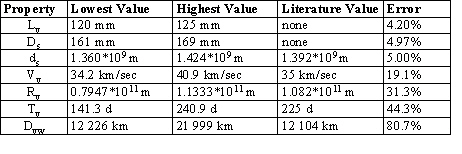|
 Deutsch Deutsch |
Error analysis |
Error analysis
I proceeded error consideration very generously generally and made a rough estimate of all uncertainties. The following errors are to be considered:
-
The determination of Sun-diameter from observations of the Mercury transit was done to large (1.424 * 109 m in relation to 1.392 * 109 m). You get an error f = +2,3%.
In all further conclusions I used this inaccurate sun diameter consciously as "my result".
-
Simplifications with the determination of the chord in front of the sun:
-
the acceptance that orbit cutouts of Venus and Earth are straight lines: In this case you set the length of chord Sv equal to the length of curve b = Rv * φ. Assuming an angle of vision φ = 0.406°, then tanφ ~ φ as well as φ / tanφ = 0.9998 is true.
-
combining the orbit plane of Venus with the ecliptic:
The levels are tilted against each other with α = 3.4°. The accepted quantity of Re extends maximally to the value Re’ = Re / cosα = Re * 1.0018
Presuming astronomical orders both approximations produce a small error within the parts per thousand range.
-
Measuring errors from my photos.
Here I estimate the errors by double calculation. I summarized the largest and the smallest values in the following table - mention as above - I proceeded generously:
with:
Lv = Chord at the picture of Sun
Ds = Diameter of Sun at the picture
ds = Diameter of Sun (true)
Vv = Orbit speed of Venus
Rv = Orbit of Venus
Tv = Time of circulation
Dvw = Diameter of Venus
While the orbit speed is still to be determined relatively exactly, the orbits become expeditious inaccurate and concomitantly the result of time of circulation as well as the diameter of Venus are very uncertain, because of the square function in Kepler’s law. In case of the diameter of Venus the largest uncertainties arise.
-
Errors at the optical system.
These errors are surely small. They are very difficult to estimate, since as well as aberrations and chromatic errors of the optical components belonging to different systems (telescope, camera and coupling of the devices) do here arise. Assuming the background of the uncertainties, which come from the photos, I disregard these errors.
It is to be stated generally, that my results of measurement have the correct orders of magnitude. Nearly all literature values are found within my indicated tolerances, the deviations however, tend to larger values.
Back to Orbit data evaluation of Venus
|
 Deutsch
Deutsch